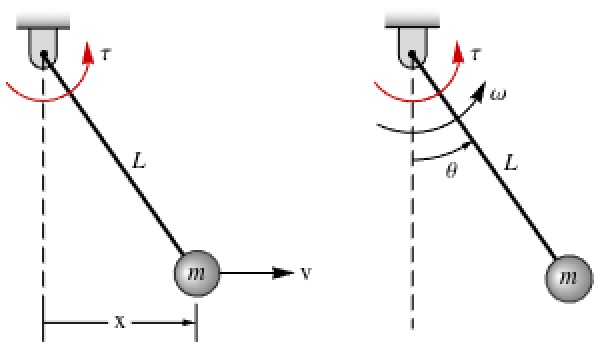StateSpaceTransform[sys,{p,q}]
transforms the state-space model sys using the matrices p and q.
StateSpaceTransform[sys,{{x1p1[z],…},{z1q1[x],…}}]
transforms using the variable transformations {x1p1[z],…} and {z1q1[x],…}.


StateSpaceTransform
StateSpaceTransform[sys,{p,q}]
transforms the state-space model sys using the matrices p and q.
StateSpaceTransform[sys,{{x1p1[z],…},{z1q1[x],…}}]
transforms using the variable transformations {x1p1[z],…} and {z1q1[x],…}.
Details and Options



- StateSpaceTransform returns a transformed model where the state variables have been transformed. The transformation can be a similarity, equivalence, or restricted equivalence transformation.
- The system sys can be a standard or descriptor StateSpaceModel, AffineStateSpaceModel, or NonlinearStateSpaceModel.
- For a standard StateSpaceModel[{a,b,c,d}], the original and transformed systems are related by the transformation
 and the corresponding equations are given by:
and the corresponding equations are given by: -






- Typically p and q are inverses, in which case the transformation is a similarity transformation. The following defaults for p and q are used for standard StateSpaceModel transformations:
-
p or {p,Automatic} {p,Inverse[p]} {Automatic,q} {Inverse[q],q} - For a descriptor StateSpaceModel[{a,b,c,d,e}], the original and transformed systems related by the transformation
 and the corresponding equations are given by:
and the corresponding equations are given by: -






- Typically p and q are invertible matrices but not inverses, in which case the transformation is an equivalence transformation. The following defaults are used for descriptor StateSpaceModel transformations:
-
p or {p,Automatic} {p,IdentityMatrix[n]} {Automatic,q} {IdentityMatrix[n],q} - For an AffineStateSpaceModel[{a,b,c,d},x] and NonlinearStateSpaceModel[{f,g},x,u] with j the Jacobian matrix D[p[z],{z}], the original and transformed systems are related by the transformation
 , and the corresponding equations are given by:
, and the corresponding equations are given by: -






- Typically p[z] and q[x] are inverses, in which case the transformation is an invertible mapping.
-
{{x1->p1[z],…},{z1,…}} q[x] is computed if needed {Automatic,{z1->q[x],…}} p[z] is computed - When variable transformation matrices {p,q} are given, the resulting system is of the same type as the input. In the case of nonlinear state-space models, these are taken to represent the transformation rules {{x1->p〚1〛.z,…},{z1->q〚1〛.x,…}}.
- When variable transformation rules {{x1->p1[z],…},…} are given, the resulting system is always AffineStateSpaceModel or NonlinearStateSpaceModel.
- StateSpaceTransform accepts the option DescriptorStateSpace.
Examples
open all close allScope (15)
Linear Transformations (10)
The similarity transformation ![]() :
:
Specify the transformation as ![]() :
:
The similarity transform ![]() for a descriptor system:
for a descriptor system:
The equivalence transform ![]() for a descriptor system:
for a descriptor system:
The corresponding matrix pair specification:
Obtain an equivalent descriptor system with the state equations premultiplied by a matrix q:
The new states are essentially the old states, i.e. ![]() :
:
For a descriptor system, the transformation with an invertible p and q gives an equivalent system:
A noninvertible p or q gives a system with restricted equivalence:
Linear discrete-time systems behave just like continuous-time systems under matrix transformations:
Transform an AffineStateSpaceModel according to ![]() :
:
Specify the transformation in terms of the new variable z:
Specify the transformation as ![]() :
:
Specify the transformation and its inverse:
Transform a NonlinearStateSpaceModel according to ![]() :
:
In terms of the new variable z:
In terms of the inverse transformation:
The transformation and its inverse:
For orthogonal matrices, Transpose can be used instead of Automatic or Inverse:
Nonlinear Transformations: (5)
Nonlinear transformations of a StateSpaceModel:
Nonlinear transformations of an AffineStateSpaceModel:
Nonlinear transformations of a NonlinearStateSpaceModel:
Specify a nonlinear transformation and its inverse:
The inverse of a nonlinear transformation is required only if operating points are specified:
Generalizations & Extensions (2)
Options (1)
DescriptorStateSpace (1)
Treat a standard StateSpaceModel as a descriptor system:
It gives the same result as an explicit descriptor specification:
Similar results can be obtained with the inverse transformation as well:
Applications (6)
A function to obtain the controllable companion form of a single-input system:
A function to obtain the observable companion form of a single-output system:
Convert the model of a simple pendulum in Cartesian coordinates to polar coordinates:

The model in Cartesian coordinates:
The model in polar coordinates:
Apply a direct quadrature (dq) transformation to a permanent magnet stepper motor model: »
Apply the dq transformation to the currents ![]() and
and ![]() :
:
Apply the dq transformation to the input voltages as well:
Convert aircraft equations of motion from body to wind coordinates:
Properties & Relations (8)
The output response is invariant under a similarity transformation:
Similar systems have identical transfer functions:
The eigenvalues (and hence, stability) are invariant under a similarity transformation:
Controllability and observability are invariant under a similarity transformation:
The Hankel singular values ![]() are invariant under similarity transformation:
are invariant under similarity transformation:
Systems model decompositions all use state transformations:
ControllableDecomposition based on ControllabilityMatrix:
ObservableDecomposition based on ObservabilityMatrix:
InternallyBalancedDecomposition based on ObservabilityGramian:
JordanModelDecomposition based on JordanDecomposition:
The linearization using coordinate transformations is also related using StateSpaceTransform:
A state transformation is an intermediate step in feedback linearization:
Apply the feedback and then the state transformation to get the transformed system:
Related Guides
History
Introduced in 2010 (8.0) | Updated in 2012 (9.0) ▪ 2014 (10.0)
Text
Wolfram Research (2010), StateSpaceTransform, Wolfram Language function, https://reference.wolfram.com/language/ref/StateSpaceTransform.html (updated 2014).
CMS
Wolfram Language. 2010. "StateSpaceTransform." Wolfram Language & System Documentation Center. Wolfram Research. Last Modified 2014. https://reference.wolfram.com/language/ref/StateSpaceTransform.html.
APA
Wolfram Language. (2010). StateSpaceTransform. Wolfram Language & System Documentation Center. Retrieved from https://reference.wolfram.com/language/ref/StateSpaceTransform.html
BibTeX
@misc{reference.wolfram_2025_statespacetransform, author="Wolfram Research", title="{StateSpaceTransform}", year="2014", howpublished="\url{https://reference.wolfram.com/language/ref/StateSpaceTransform.html}", note=[Accessed: 02-November-2025]}
BibLaTeX
@online{reference.wolfram_2025_statespacetransform, organization={Wolfram Research}, title={StateSpaceTransform}, year={2014}, url={https://reference.wolfram.com/language/ref/StateSpaceTransform.html}, note=[Accessed: 02-November-2025]}